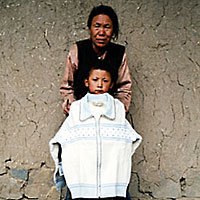
Children in Tibet/China
In Tibet, the Association works mainly in the villages of the Shigatse region in Central Tibet where the average altitude is of 4000 meters.
The living conditions in these villages are very hard. The houses are built simply from mud bricks with a stove as the central feature and few windows to stop the cold from entering: there is no water, electricity or heating, but many people also have to live with no furniture, mattresses or blankets.
People survive by tending livestock and on the meagre harvests produced in this kind of hard and dry mountainous environment, but often this is only enough to last the family for 6-7 months of the year. Most families have nothing to sell and therefore have no money to dress their children or buy school materials. Children often have to confront the harsh Tibetan winter with the few ragged clothes they are wearing and with whatever footwear they can find.
The climate is extremely cold and arid in this region, a situation worsened by a dramatic scarcity of water. Most villages have no aqueduct or water pump and there are no basic sanitary services. There are no healthcare facilities and those present in the city are expensive and too far away due to the lack of transport. The village schools, that exist, are attended by few children as parents do not have even the small amount of money needed to buy books and other school materials. There are no shops in these villages and no postal services.
Due to the altitude and severe climate trees are rare and the only sources of fuel are dried shrubs and yak dung. There is a severe lack of nutritious fresh fruit and vegetables.
Here, in these villages, help is divided equally between all the children and their families: every family receives a stock of food for the winter, sacks of rice, flour and barley seeds; children receive, other than money, clothes, school uniform, shoes, school materials, soap…
The help is also used to improve the general living conditions of the surrounding community through the realization of sanitary and educational infrastructures.
